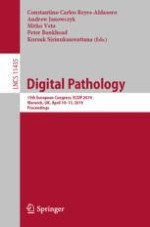2019 | Buch
Digital Pathology
15th European Congress, ECDP 2019, Warwick, UK, April 10–13, 2019, Proceedings
herausgegeben von: Constantino Carlos Reyes-Aldasoro, Andrew Janowczyk, Mitko Veta, Peter Bankhead, Korsuk Sirinukunwattana
Verlag: Springer International Publishing
Buchreihe : Lecture Notes in Computer Science
